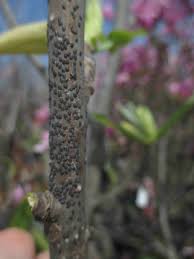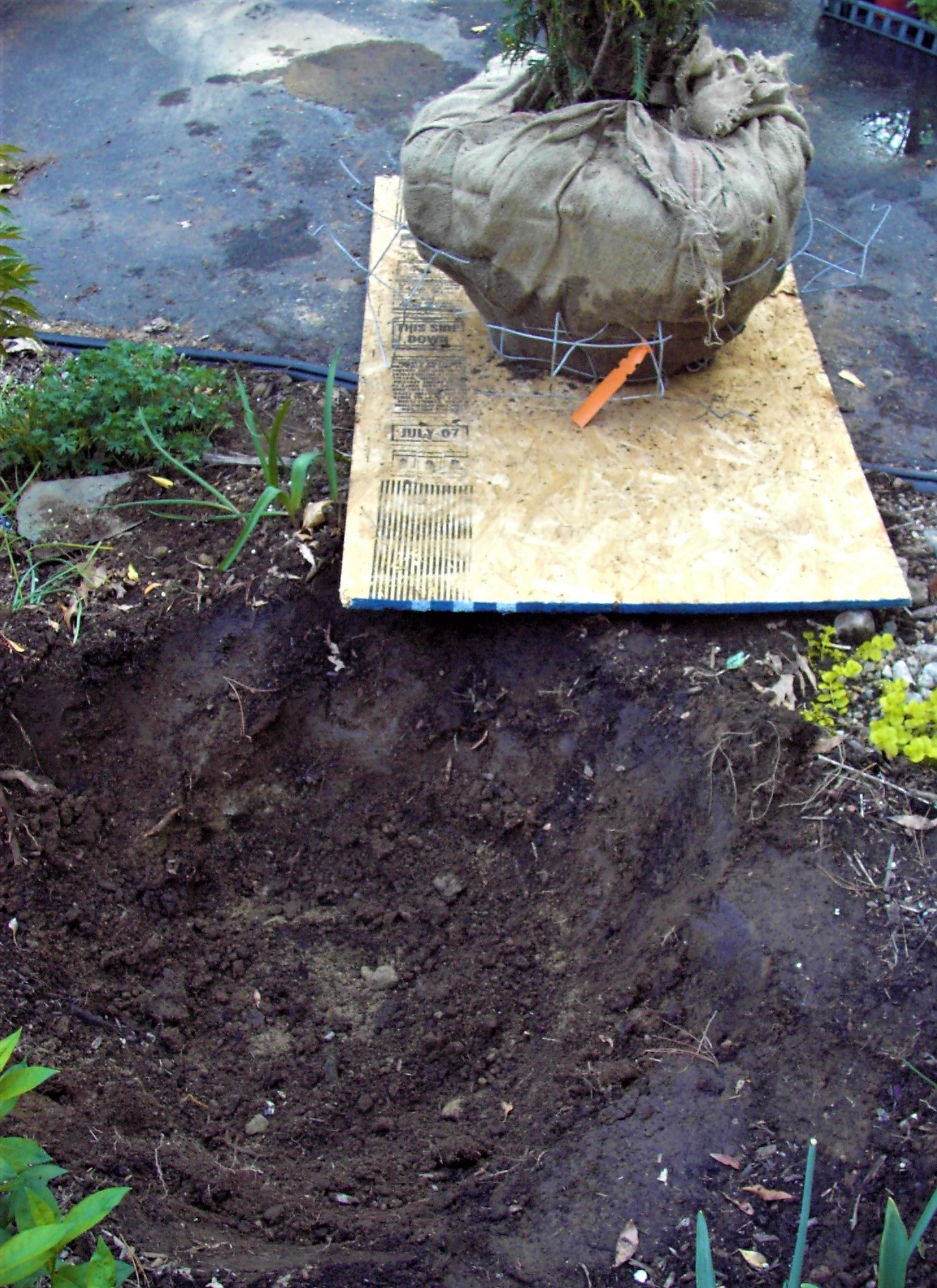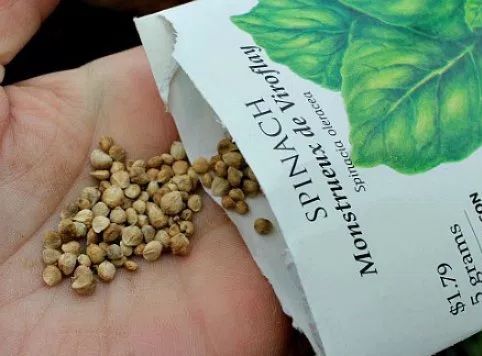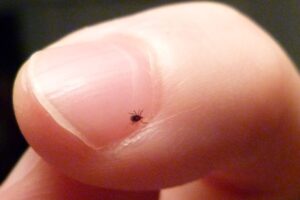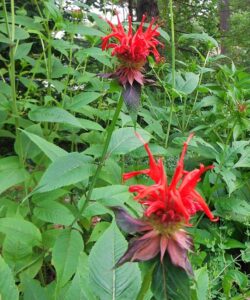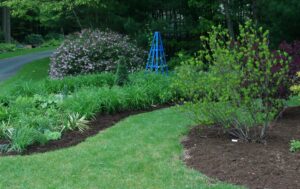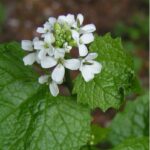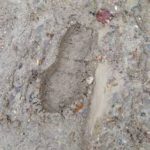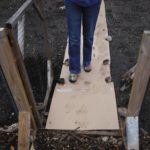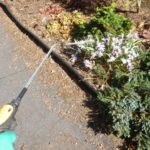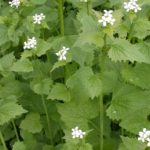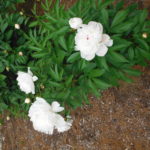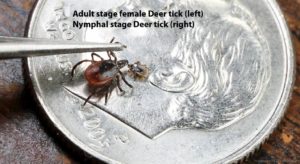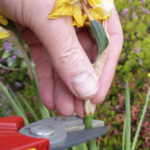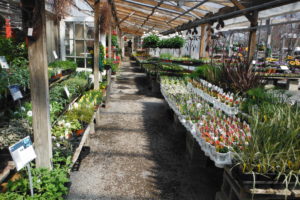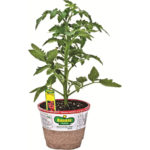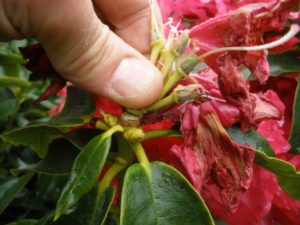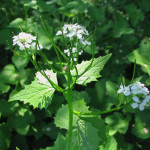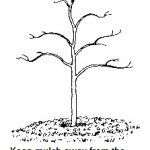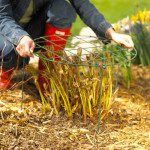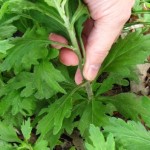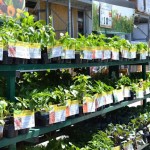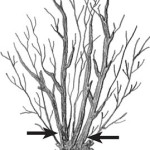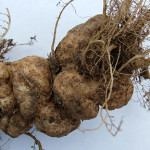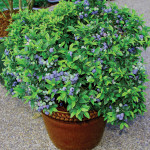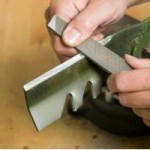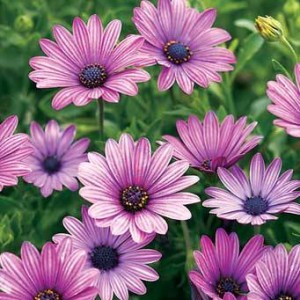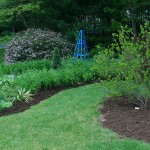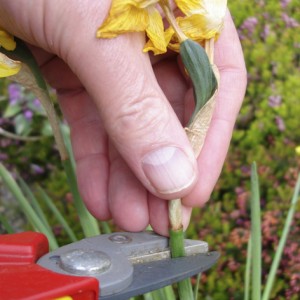Horticultural Hints – May
Early May is the right time for a second application of horticultural oil to manage pests on trees and shrubs. Horticultural oil is not a pesticide — it works by smothering eggs so they cannot hatch.
Shrubs, trees, and certain perennials are fine to plant now. Anything that can survive our winters should be going into the ground this month. The earlier you get trees and shrubs in, the longer they have to establish their roots before the heat of summer takes hold. Perennials also benefit from time to settle into their new home. And, because rainfall so far this season is several inches below normal, it is vital your plants get adequate water when there are no watering restrictions.
Protect your tender plants against deer. Those hostas and other perennials that are just emerging for their new season are taste treats for deer, rabbits, and other herbivores. Your best bet to protect your investment in those plants is to make them taste terrible. There are several commercially available preparations (Bobbex and Liquid Fence are two examples) that consist of putrefied eggs, mint oil, garlic, and other ingredients that deer and rabbits find noxious. These preparations are applied using a home sprayer. A spraying of all new foliage is best when no rain is in the immediate forecast. For an hour or two, your yard will smell terrible. Once the sprays dry, humans no longer detect them but deer and rabbits avoid treated plants for up to a month.
Vegetable gardens. If you don’t have beets, spinach, lettuce, swiss chard in the ground, do it immediately. When planting members of the cole family such as cabbage, broccoli and cauliflower, add lime to the soil because the resulting higher pH (more alkaline soil) inhibits soil-borne diseases that can remain in the ground for up to seven years after first appearing and can devastate cole crops.
After spring bulbs pass their bloom, allow foliage to yellow and ‘ripen’ before being removed. It’s important because the foliage is responsible for passing the nutrients down into the bulb that will allow it to produce a new flower next year. Hide the foliage by growing perennials and annuals around it. When the foliage turns brown, cut it at ground level, secure in the knowledge that your favorite spring bulbs will return in 2023.
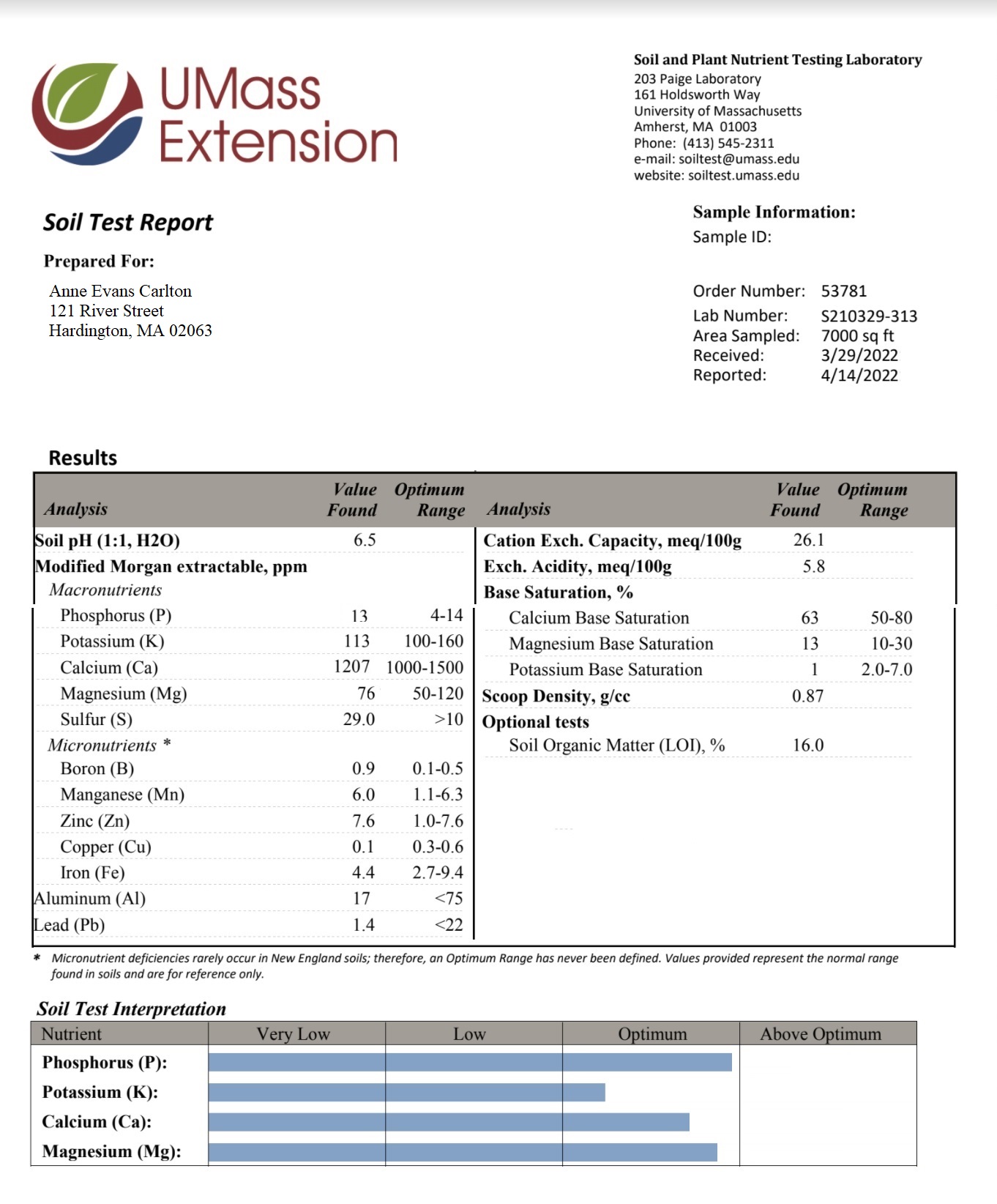 Resist the temptation to feed your lawn repeatedly. Instead of purchasing multi-step ‘programs’, find out what your lawn really needs with a reasonably-priced, highly accurate, and unbiased soil test from https://ag.umass.edu/services/soil-plant-nutrient-testing-laboratory/ordering-information-forms. Healthy lawns need a large population of beneficial insects, bacteria and microbes to make nutrients available to the roots. Lawn insecticides indiscriminately kill these good guys along with the bad so reconsider annual applications of “insect control”.
Resist the temptation to feed your lawn repeatedly. Instead of purchasing multi-step ‘programs’, find out what your lawn really needs with a reasonably-priced, highly accurate, and unbiased soil test from https://ag.umass.edu/services/soil-plant-nutrient-testing-laboratory/ordering-information-forms. Healthy lawns need a large population of beneficial insects, bacteria and microbes to make nutrients available to the roots. Lawn insecticides indiscriminately kill these good guys along with the bad so reconsider annual applications of “insect control”.
May is the month to fertilize your perennials. They’re entering their growth cycle for their late spring and summer displays, and the fertilizer ‘boost’ will ensure a long and colorful display as you add the nutrients to bolster both root and flower production. But remember: when applying fertilizer, less is best.
It’s tick season. Whenever you go out to garden, take a few seconds to spray your clothing – especially below the knees, but a spritz elsewhere – to deter ticks that want to jump on anything warm-blooded for their next meal. Use a spray that specifies it uses EPA-registered ingredients that are tick repellents. These include DEET, oil of lemon eucalyptus, and PMD. New England ticks now carry not just Lyme disease, but pathogens that destroy white blood cells (Ehrlichiosis) and red blood cells (Babesiosis).
Dig and divide perennials. Your favorite perennials should all be up by now, but have not yet set flower buds. This is a terrific time to divide them. The plant will benefit from discarding its dead center. Use a spade to divide the perennial into sections; return the largest one to the original site, and plant the others wherever you want color and texture or donate them to your garden club’s plant sale.
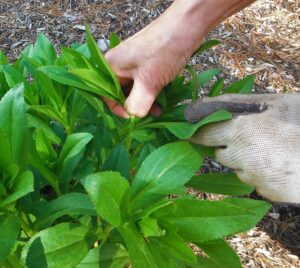
Pinch back perennials like this shasta daisy to get more blooms on a better-shaped plant later this summer. Do your first pinch on Mother’s Day, your second on Memorial Day.
Pinch me! Now is the time to ‘create’ shorter plants with lots of flowers instead of leggy giants. You need to pinch back plants like asters and chrysanthemums four times during the spring and summer. Here’s an easy mnemonic: pinch them back Mother’s Day, Memorial Day, Father’s Day and the Fourth of July. With Mother’s Day this Sunday, it’s time to make your first pinch.
Thin your seedlings the right way. By now, vegetable seeds you planted in April have germinated, and it’s time to thin your seedlings to a number that will grow, thrive, and not crowd one another. If you are tempted to pull out excess seedlings roots and all, don’t do it! Instead, snip unwanted seedlings with scissors. Pulling out seedlings by their roots inevitably disturbs their neighbors. And, try not to touch your remaining seedlings as you thin them. Fungi from elsewhere in the garden can be transmitted by your fingers or gloves without you ever knowing it was there.
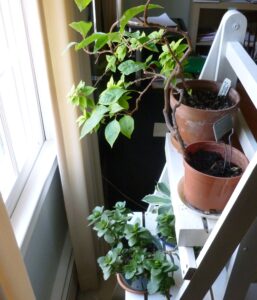
Now that sunlight is strong for much of the day, keep houseplants away from glass that might cause scorched leaves
Protect your houseplants from excessive sun and heat. Plants that grow indoors are dependent upon you to ensure they don’t get burned with the approaching summer. The May sun is intense and days are rapidly lengthening. Move houseplants away from windows with long sun exposure, and place them where fewer hours of direct light (and easterly or northern window rather than a west or south one.)
Plant pollinators. Instead of trusting plant tags with tantalizing but often meaningless promises, there is now a wealth of information on plants available via websites – both annuals and perennials – that attract birds, bees, and butterflies (and sometimes bats). Check sites such as Grow Native Massachusetts (https://www.grownativemass.org/Great-Resources/databases), where you’ll find links to New-England-centric resources (including Native Plant Trust’s ‘Go Botany’ site (https://gobotany.nativeplanttrust.org/), an easy-to-use tool for finding out which plants match your specific needs.
Great news on the drought front. What a difference a few weeks makes! The latest Drought Monitor shows the ‘moderate drought’ across New England has substantially receded, as has the ‘abnormally dry’ conditions. The U.S. Weather Service forecast for the region indicates continued above-average precipitation. Monitor rainfall with an inexpensive rain gauge so you don’t waste time or water by watering when the plants don’t need it.
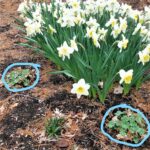
The lady’s mantle ringing these daffodils is barely visible in early May. By late June it will hide the daffodil foliage
After spring perennial bulb blooms fade, allow foliage to yellow and ‘ripen’ before being removed. This is important because the foliage is responsible for passing nutrients down into the bulb to produce a new flower next year. You can hide the foliage by growing perennials and annuals around it. When the foliage turns brown – likely in June – you can safely cut it at ground level, secure in the knowledge that your favorite spring bulbs are ready for next spring.
It’s been a cold wet spring so far, making now a good time to start your vegetable garden. Cold weather crops – lettuce, peas and onions, for example – can be planted now. But many vegetables everyone loves: tomatoes, beans and squash, want soil temperatures of 60 or 70 degrees (or higher), which may appear until June. Lay out your garden and put up a fence now, but delay purchasing pots of tomato, pepper, melon and other hot weather crops until it is closer to the time to set them out. Your garden will be more bountiful for starting at the right time.
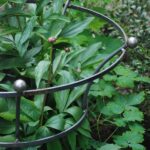
It’s easy to put peony rings around your emerging plants now and ‘guide’ them to behave as they flower
If you grow peonies, place peony rings around the plants before they become too big and hard to corral. It’s a lot easier to guide the stems of this top-heavy perennial into a ring than to stake individual stalks. After the peony flowers have passed, the rings can be useful keeping other exuberant growers in line later in the summer.
Do you want shorter plants with lots of flowers instead of leggy giants? Pinch back plants like asters and chrysanthemums four times during the spring and early summer. Need an easy mnemonic: pinch them back Mother’s Day, Memorial Day, Father’s Day and the Fourth of July. You’ll be glad you did come summer.
If you apply mulch in your flower beds, remember not to overdo. Two inches of mulch is usually enough to prevent weeds from germinating. Just as important, more mulch isn’t better. A too-thick layer (of three or more inches) blocks sunlight and prevents rising temperatures from warming the soil.
Have you noticed garlic mustard in your yard or along roadways? It is an invasive weed that dominates woodlands and prevents native species useful to wildlife and trees(!) from growing. Don’t give garlic mustard a break just because it’s an early bloomer. It produces many seeds that stay viable for two years. When you see it, pull it or you’ll kept busy for years getting rid of it.

While we can’t visit gardens yet, we can take virtual tours like this fly-over of the daffodil field at Tower Hill Botanic Garden
It’s unlikely any of us will be visiting any major gardens this month. But you can take a virtual tour. The New York Botanical Garden (https://www.nybg.org/nybg-at-home/), for example, provides a continually updated series of video ‘walks’ through its 250 acres. Tower Hill Botanic Garden (https://www.towerhillbg.org/online-educational-resources-adults-2/) offers several virtual tours, including a wonderful drone’s-eye ‘flyover’ of its daffodil fields that you could never take in person.
Soggy Spring. All the rain we received in April means some garden chores should be delayed until the soil dries out. If you find you are leaving impressions in the lawn or footprints in the garden, stop. Compacting soil is a bad idea because you are pushing out the air roots need to breathe (and yes, roots breathe) and preventing water from flowing through. It is very hard to get rid of footprints (or cart and tool tracks) once they have been made.
Plain brown cardboard (your Amazon boxes?) placed on the paths of your vegetable garden will reduce soil compaction and keep weeds from germinating in the aisles. The cardboard will break down by season’s end and, as it does, it adds carbon to the soil.
Early May is the right time for a second application of horticultural oil to manage pests on trees and shrubs. Horticultural oil is not a pesticide—it works by smothering eggs so they cannot hatch
May is also the time to educate the deer and bunnies that your garden is not their cafeteria. Apply foul smelling sprays containing putrefied eggs and garlic oil. These sprays quickly lose their scent to humans noses, but leave a bad taste in the mouths of those who try to eat them. Do not apply them to food crops!
As your bulbs finish blooming, you should deadhead the flowers, but leave the foliage alone. Those bulb leaves are working hard to store nutrients in the bulb for next year’s flowers. If you cut foliage off now, the bulb may not reappear next spring. Leave foliage alone until it has turned completely yellow (and that means no braiding or tying it up). Not thrilled with the look of that yellowing foliage? Plant annuals between the bulbs and enjoy their display this summer.
Garlic mustard is an invasive weed that chokes out native plants and spreads wildly. Look for its small white flower and light green leaves, in your garden and along streets and roadways . In early May, it pulls out easily. Bag it and send it to your transfer station to be incinerated.
As your spring flowering shrubs and trees finish blooming, prune them. If you wait until summer, you may be pruning off next season’s flower buds. Didn’t get as many blooms as your hoped from those shrubs? Scratch a light application of fertilizer into the soil now. It is not necessary to buy a special fertilizer for acid-tolerant plants such as rhodendrons, azaleas and blueberries; our New England soil is naturally acidic.
Peonies are up and growing now. When the rains stop, don’t let the plants dry out. And, for larger (show worthy) blooms, pick off the side buds on each stem leaving only the terminal (main) bud.
Include herbs such as thyme, sage, oregano and dill in your vegetable garden or flower beds. Many herbs repel foraging animals. Dill attracts a number of butterflies, so be prepared to sacrifice a branch or two of the vigorous plant to their caterpillars in exchange for their beauty. Thyme makes a great ground cover for hot dry area, especially on slopes where mowing may be tricky.
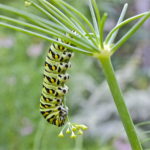
Fennel and dill are two of the hosts for the caterpillars that will become black swallowtail butterflies
When you thin beets, replant the seedlings. Unlike other root crops, they take well to the process. And as you harvest lettuce, start another patch for a late spring crop, growing it where it will be shaded later by taller or bushier companions. The lettuce will thank you as temperatures rise.
Plant onions in triple rows. As they grow, remove the ones in the middle to use first giving the others rooms to grow.
Earlier years May Hints:
Good News, bad news. First, the good: ‘real’ spring has arrived. New England is drought-free with precipitation two inches above average year to date. (To see how far we’ve come, scroll down to the May Drought Monitor maps for 2016 and 2017.) More good news: gypsy moth populations are at exceptionally low levels thanks to last year’s wet spring. The bad news is that the deer tick population is exploding, and the Lone Star ticks (as well as others) are now firmly established in New England. That means in addition to Lyme Disease, we are confronted with Ehrlichiosis and Babesiosis; all serious blood-borne diseases. In May, ticks are about the size of the period at the end of this sentence, but they’re still carry diseases. Before working in the garden, use a spray or powder containing permethrin (a synthetic chemical that mimics an extract of chrysanthemum flowers) to treat clothing, and spray a repellent containing DEET on skin or clothing for protection. Check family pets as well as family members.
In the flower garden. Remove spent blossoms from spring bulbs but do not cut back, or braid, foliage until it turns yellow. Those leaves are busy producing food for next spring’s flower. If you’re growing peonies, fertilize and pinch off side buds to promote larger main blooms.
When your bulbs have faded, consider planting annuals around the foliage. The new plants will quickly grow, hiding the yellowing foliage while adding some color to the area.
The garden center displays are tempting, but hold off planting marigolds, zinnias, coleus, petunias and other summer annuals until Memorial Day when the soil is warm and all danger of frost is past. These plants resent cold soil and cold nights.
Have you ever grown rhubarb? It’s an easy to grow perennial – meaning it comes back every year. It’s high in calcium, speeds metabolism, reduces cholesterol, and is very low in calories. Choose thin, firm, bright red stalks to serve in pies and as a side dish or relish with poultry and pork. But discard the leaves: they are toxic and definitely not edible.
It’s much too soon to set out tomatoes, peppers, eggplant and melons. They need soil (not the air) warmed to at least 60 degrees. And remember they require being planted where they receive a minimum of 8 hours a day of sunlight to grow and produce. Wait until June for these summer staples.
Floating row covers can give your early crops a few degrees of protection on cold nights. Even better, they provide a physical barrier to insects such as aphids, leaf miners, bean beetles, cabbage worms and others. It’s a chemical-free way to save your crops from destruction by these pests and others. Row covers are not difficult to find, they are widely available online, in catalogs and at better nurseries.
Think containers. Do you lack a sunny space large for an in-ground vegetable garden? It doesn’t have to be an impediment. More and more seed companies are offering vegetables intended to be grown in containers. A few containers can provide a summer’s worth of fresh vegetables on your patio, alongside the driveway, or any place the sun shines. Just remember containers will need more frequent watering, especially when the weather heats up.
Pruning tip. As soon as your early flowering trees and shrubs (including forsythia, rhododendron, azaleas, lilacs, dogwoods, crabapples and redbuds) finish blooming, prune them back to promote the largest possible flower display next year. Pruning later in the summer removes next year’s buds.
Water newly transplanted trees and shrubs immediately after planting and throughout the summer. An inexpensive rain gauge – or even a tuna can – will help you keep track of how much rain has fallen each week so you know when and how much additional water is needed on gardens, lawns and new plantings.
May 2017
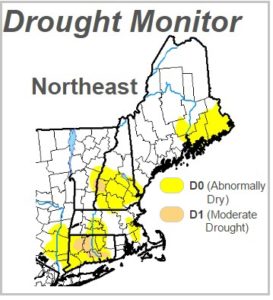 Hopeful signs on drought. Eastern Massachusetts had more than seven inches of rain in April, compared to normal April precipitation of less than four inches. Four months ago, drought covered all of the state, including 36% considered to be in ‘extreme’ drought. At the end of April, a quarter of Massachusetts is still ‘abnormally dry’, including Boston and areas to its west and south. Our April showers may bring May flowers, but we’re not in the clear. The United States Drought Monitor also notes that groundwater in much of New England – the source of much of our drinking water – remains ‘unfavorably low’. You should continue to plan your garden to need less water, and ‘water with an eyedropper’ when you must.
Hopeful signs on drought. Eastern Massachusetts had more than seven inches of rain in April, compared to normal April precipitation of less than four inches. Four months ago, drought covered all of the state, including 36% considered to be in ‘extreme’ drought. At the end of April, a quarter of Massachusetts is still ‘abnormally dry’, including Boston and areas to its west and south. Our April showers may bring May flowers, but we’re not in the clear. The United States Drought Monitor also notes that groundwater in much of New England – the source of much of our drinking water – remains ‘unfavorably low’. You should continue to plan your garden to need less water, and ‘water with an eyedropper’ when you must.
Everyone is anxious to get planting in their garden. And the stores seem to abound with annuals and even vegetable seedlings, but don’t be deceived by the displays. Unless your garden is in the city, or in a sunny spot sheltered from winds, you should not begin putting in annuals until later this month. Experienced gardeners remember killing frosts even after Memorial Day in the recent past. And if a cool spell doesn’t kill a tomato seedling or a marigold, I can guarantee that it will stunt its growth.
If you need to start gardening with vegetables or annuals, choose plants that can take a bit of chill. Your vegetable garden should already have peas, spinach, lettuce and beets growing. Onion sets and leeks started indoors should be out, but be ready to cover them with a double layer of row cover, or an old sheet on nights when the temperature drops below 40 degrees. You should definitely wait until June to put out tomatoes, peppers, cucumbers and squash. Dusty miller and snapdragons do well in May and let you get a start on bedding plants or container gardens, but don’t tempt fate with New Guinea impatiens, marigolds or geraniums.
Shrubs, trees, and certain perennials are fine to plant now. Anything that can survive our winters should be going into the ground this month. The earlier you get trees and shrubs in, the longer they have to establish their roots before the heat of summer takes hold. Perennials also benefit from time to settle into their new home. And, after last year’s drought, it is vital that this year trees, shrubs and perennials get adequate water if there are no watering restrictions.
Help out pollinators and the environment. Plant native shrubs in your garden. Sweet shrub has interesting reddish brown flowers and a delicious scent that keeps coming all summer if you plant the native species (Calycanthus sp.) Want to attract (and feed) native pollinators? Skip the butterfly bush and look for Devil’s Ninebark (Physocarpus opulifolius) — a shrub with colorful leaves and flowers that attract more bees, butterflies and friends than you would ever imagine.
Pruning (again). Prune back spring bloomers as soon as the flowers are gone. Cutting off those dead blossoms gives you the opportunity to shape the bush and control its size before it gets out of hand. Further, pruning promotes the growth of new wood that will bear next year’s flowers.
Lawn maintenance. Spring is not the time to feed lawns in New England, no matter what you hear on radio and television. Lawns should be allowed to grow to three inches (yes 3) so that they can use the extra length to shade out weeds and pump food into their roots. Short lawns are more susceptible to weeds and drought. Raking a thin coating of good quality compost into your lawn (one-quarter to one-half inch) is all the food it needs.
Previous Years Hints: 2016 and earlier
Do you see that tall, four-petaled, white-blooming flower that is in bloom right now? The one that seemingly came out of nowhere? It’s called garlic mustard (alliaria petiolate) and, right now, it is now popping up all over wooded areas in New England. It’s a nasty invasive plant. If you see it (it usually grows in large stands), pull it out, tear off its roots, and dispose of the leaves and flowers. Here’s why: it will out-compete tree seedlings for light and moisture, and its leaves are toxic to several species of butterflies and moths. It may look pretty right now, but it is no one’s friend.
Mulch, Mulch, Mulch. Mulch is a gardener’s best friend and May is the right time of year to apply it in New England. Mulching everything will cut water bills on what is forecast be a below-average-precipitation summer. Mulch keeps the soil around plants cooler in summer heat. It prevents weeds from popping up to compete with plants you want, and saves water by reducing evaporation from the soil. Bark mulch is acceptable, but your plants will be happier if you use leaf mulch or just chopped-up leaves from last fall. The partially broken down leaves will finish decomposing and add nutrients to your soil after the year is finished. Didn’t save your leaves? Leaf mulch is commercially available.
How deep to mulch? An inch is too little; two-to-three inches is just right depending on location; and more than four inches inhibits water from getting to the soil below. When you mulch, remember to keep mulch a few inches away from the bark of trees and shrubs, and a couple inches away from the stems of perennials, annuals and vegetables. Mulch “volcanoes” are a sure way to kill a shrub or tree.
Stake tall garden perennials while they are still small and easy to handle. To prevent “bunchy” plants such as peonies and baptisia from flopping over from the weight of their flowers, use commercially available single or double rings to hold stalks and flowers upright. Use individual stakes for delphiniums. Often these supports can be removed after the flowers have passed and their heavy heads are gone.
Pinch me! Around Mother’s Day, pinch back chrysanthemums to generate shorter but bushier plants with more abundant flowers. This technique works well with many other multi-stem perennials such as asters. A second pinching just before the Fourth of July will result in slightly later, but noticeably more flowers in the fall.
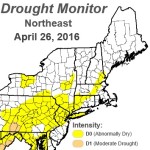 It’s not as wet as we hoped this spring. The most recent U.S. Drought Monitor shows central Massachusetts and Connecticut are already in a “D0” condition, or abnormally dry. Protect you investment in new plantings by watering them on a regular schedule if your area isn’t getting an inch of water a week or more. A rain gauge is as important as your trowel or hoe. It may rain heavily where you work and barely at all where you garden. Water new perennials the first season, new shrubs for one to two years, new trees for two to five years (depending on how large the tree was when you put it in.) The larger the plant, the longer it will to grow enough roots to find sufficient water on its own. Do not fertilize new plantings—they need to get established before being encourage to grow.
It’s not as wet as we hoped this spring. The most recent U.S. Drought Monitor shows central Massachusetts and Connecticut are already in a “D0” condition, or abnormally dry. Protect you investment in new plantings by watering them on a regular schedule if your area isn’t getting an inch of water a week or more. A rain gauge is as important as your trowel or hoe. It may rain heavily where you work and barely at all where you garden. Water new perennials the first season, new shrubs for one to two years, new trees for two to five years (depending on how large the tree was when you put it in.) The larger the plant, the longer it will to grow enough roots to find sufficient water on its own. Do not fertilize new plantings—they need to get established before being encourage to grow.
Don’t be fooled by the displays at some nurseries, and especially at the big box stores, In early May, home centers in New England began selling tomatoes and basil, marigolds and geraniums, a month before the temperatures are consistently high enough to allow safe planting. Use a thermometer to check the soil temperature about four inches below the surface, and avoid being fooled by warm (air temperature) days.
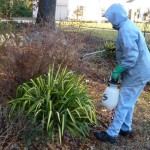
Spraying with a commercially available solution of putrefied eggs and garlic will help deter browsing deer. You may want to avoid getting the stinky spray on your clothing and skin.
Protect your tender plants against deer. Those hostas and other perennials that are just emerging for their new season are taste treats for deer, rabbits, and other herbivores. Your best bet to protect your investment in those plants is to make them taste terrible. There are several commercially available preparations (Bobbex and Liquid Fence are two examples) that consist of putrefied eggs, mint oil, garlic, and other ingredients that deer and rabbits find noxious. These preparations are sprayed on using a standard gallon-sized home sprayer. A light spraying of all new foliage is best, when no rain is in the immediate forecast. For an hour or two your yard will smell terrible. Once the sprays dry, humans no longer detect them but deer and rabbits do for up to a month.
Impatiens update for 2016: While the New Guinea impatiens continue to thrive, ‘standard’ impatiens are still being destroyed by an imported fungus that hits the plants at any time during the season. Until you see banners announcing fungal-proof impatiens, go for alternatives.
Previous Years May Hints
Ready Set Garden!
Finally the soil has warmed enough to start serious gardening. Your clean-up should be finished and the real work beginning.
Prune forsythia, lilacs and other spring bloomers as soon as the flowers are finished. They will bloom next year on the wood that grows during the summer, so delaying could mean fewer flowers next year. Remember that forsythia is a prodigious grower, so prune the bush smaller that you want it to be now because the summer growth spurt will come soon enough. With lilacs it is important to prune not the ends of branches (though you can do that to control size) but, rather, to take out up to one-third of the older branches at ground level on established plants. Lilacs renew themselves by sending up new shoots and, in two years, those shoots will have the biggest and best flowers.
Vegetable gardens. If you don’t have beets, spinach, lettuce, swiss chard in the ground, do it immediately. When planting members of the cole family such as cabbage, broccoli and cauliflower, add lime to the soil because the resulting higher pH (more alkaline soil) inhibits club root, a soil borne disease that remains in the ground for up to seven years after first appearing and can devastate cole crops.
Covering crops with floating row covers (available in nurseries or online) can prevent flea beetles, leaf miners, and root maggots (cole crops). Later, you can use floating row covers over beans and squash to prevent bean beetles and squash borers from attacking to the plants. If you want good crops organically, this is the easiest and least expensive (they are reusable) way.
Don’t let an early May burst of heat fool you into setting out hot weather vegetables such as tomatoes, peppers, eggplant, squash and melons. Wait until the end of May. It is soil, not air temperature that these vegetables need to have warmed to 70 degrees or more. Otherwise they may rot in the ground or be stunted. If you worry your favorite varieties will be out of stock by then, buy the plants now, but instead of planting, put them outside in the morning and back in for the evening until the soil has warmed.
Lawns. You raked your lawn last month. This month, make certain the mower is set to 3 to 3 1/2 inches. If someone else mows your lawn, tell them you don’t want a 2-inch lawn because it’s not as healthy and needs much more attention to keep it green. That extra inch (or more) of grass will help shade the roots during the heat of summer, keeping them cooler, preventing water from evaporating as fast and shading out possible weeds.
It’s too late to reseed this spring — you’ll only be helping the weed seeds grow with the additional water and fertilizers you’ll be using. If the grass closest to the road is totally dead, it is likely the result of the heavy applications of road salts this past winter. The soil has been poisoned. Remove and discard the top three inches of soil. Put down fresh soil and sod if you want grass. Or fresh soil and a hardy ground cover. Or fresh soil and annuals. Or just cover the area with four inches of mulch for the summer and start grass come September.
Summer annuals. Once the air temperature are consistently in the fifties at night, you can begin planting summer annuals in the ground or in containers. Impatiens are still a bad bet because of the persistent fungal disease. Branch out and try less well known plants and vegetables (rainbow chard is beautiful and have you ever seen the flowers on okra?) Or, use perennials and even compact shrubs in your containers for longer seasons of interest. Breeders have developed new varieties of raspberries and blueberries, many specifically for growing in pots, that offer pretty and tasty new looks.
Previous Years Hints: May 2014
After spring bulbs pass their bloom, allow foliage to yellow and ‘ripen’ before being removed. It’s important because the foliage is responsible for passing the nutrients down into the bulb that will allow it to produce a new flower next year. Hide the foliage by growing perennials and annuals around it. When the foliage turns is dead – likely by July – you can safely cut it at ground level, secure in the knowledge that your favorite spring bulbs will return in 2015.
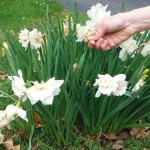
Deadhead bulbs as their blooms pass, but leave the foliage in place until it begins to yellow, which will likely be in July.
If you notice areas where you wish there were more bulbs, make note of them now in your garden journal and mark the areas with brightly colored golf tees. Even if other plants grow up around the tees, they should still be there in the fall to show you where to plant for next year’s display.
While we are all anxious to put the long winter and cold spring behind us, keep in mind that a few cold nights can stunt tender annuals for the season, and a night with temperatures in the low thirties can kill them. So if you have purchased marigolds, geraniums or petunias, watch the thermometer and cover any tender annuals nightly until the danger of frost is past.
Plant growers are saying there is still no cure for impatiens blight. New Guinea impatiens seem to be unaffected, but regular impatiens have no resistance and will be killed. Some nurseries are offering expanded varieties of other shade lovers such as wax begonias, colorful coleus and torenia.
In the vegetable garden, your cold weather crops should be in the ground now and well underway. Keep a check on soil (not air!) temperature before planting beans, carrots and beets (60°), squash, cucumbers, peppers and tomatoes (70°). Don’t even think of planting eggplant or melons until June when the soil and air are both warm enough (80°). Your garden will be more bountiful for starting it at the right time.

Floating row covers like this one will both protect from spring insects and chilly nights that can stunt the growth of your annuals and vegetables.
Floating row cover can provides two benefits in the vegetable garden. First, it is a physical barrier against enemies such as bean beetles and flea beetles (that attack kale, oriental vegetables, tomatoes, eggplant and more). Secondly once installed it can also provide several degrees of protection from cool night time temperatures. It’s not enough protection to plant tomatoes yet, but it may let you “cheat” by a week or more.
Lawns are starting to green up naturally now as the grass recovers from winter. Mowing your lawn at three inches allows the grass to shade out weeds by depriving their seeds of sunlight. Leaving your grass clippings behind adds nitrogen and other necessary nutrients to the soil without creating thatch.
Resist the temptation to feed it repeatedly and find out what your lawn really needs with an accurate and low cost soil test from soiltest@umass.edu. Healthy lawns need a large population of beneficial insects, bacteria and microbes to make nutrients available to the roots. Lawn insecticides indiscriminately kill these good guys along with the bad so reconsider annual applications of “insect control”.
Prune back spring bloomers as their flowers die. Shrubs such as forsythia, quince, kerria, spirea and lilac all bloom on old wood which means that shortly after they finish flowering they begin the process of setting buds for next year. To keep bushes in shapely and in good condition, prune them for size and shape as soon as this year’s flowers have finished.
Earlier years hints: May 2013
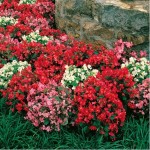
Bedding begonias make a terrific alternative to impatiens. Flowers are long-lasting and need no deadheading.
Don’t Buy Impatiens This Year! The impatiens blight, also known as ‘downy mildew’, that struck in 2012 is still present in the soil (the cold winter did not kill it) and will likely kill any impatiens you put out there this year, according to the Cornell Cooperative Extension Service. This advice remains current for 2014. Responsible nurseries will not be selling impatiens but reports are that ‘big box’ stores will. Don’t waste your money on something that is almost certain to die early in the season. The blight is both soil- and wind-borne so, even if you didn’t have it last year, it almost certainly will have infected your area. Here is a comprehensive article on the subject.
What to plant in shady areas until the industry breeds resistant impatiens? Bedding begonias offer color from both flowers and foliage. They are also less thirsty so you will save on watering time and costs. Coleus offers a world of colors and patterns these days allowing you to explore how exciting your shade can look without flowers. Other suggestions would be Torenia, which brings true blue to the shade garden or hostas—a perennial that ends the annual planting chore and are amazing drought-tolerant once established.
Boxwood Blight. There seems to be no end to the new diseases and pests. Hopefully you are up to date on Emerald Ash Borers and Asian Long Horned beetles; two unwelcome insects that are threatening the trees of New England. Boxwood blight made its first appearance in this country in 2011 and has been found throughout southern New England, unfortunately including Massachusetts. This article provides more information on this threat to your boxwoods.
Dry April. Dry Summer? No one knows for certain if we’ll have a dry summer but we are starting the growing season with very dry soil, and reduced ground water. For most of us this means watering bans. So, prioritize and make the most of the water you have. Grass will recover easily from a summer drought; trees, shrubs and perennials may not, so concentrate your watering on them. And do it correctly: watering slowly and deeply so water gets to the roots and does not run off. One deep watering a week will do much more good than frequent shallow waterings.
Mulch to Save. One way we can help plants survive a drought is to mulch properly. Mulch prevents evaporation of moisture from the soil and helps to keep the soil cooler during summer hot spells, as well as reducing competition for water from weeds. But this is a case where ‘more’ is not better. Two inches of mulch is enough to keep weeds at bay, anything more than three inches will prevent water from effectively reaching the soil. Never place mulch touching the trunks of trees or stems of plants—it opens a path for insects and disease to enter the plant.
Lawn Care. Keep your mower blade sharp — a dull blade tears the grass, opening it to disease. Mow high: the taller the grass, the deeper the roots. And, deep roots will find water that shallow roots cannot. May is too late to apply crabgrass preventer or grub control. Instead, wait until July for common grub control. If you lift a shovel’s worth of turf and find fewer than 8-10 grubs, there is no need to treat. Using unnecessary pesticides kills the beneficial insects, earthworms and microbes that help keep pests in check.
Vegetable Garden. Keep planting lettuce, beets, carrots, chard and radish seeds. Plant any cabbage, broccoli and cauliflower before the hot weather begins, and then place row cover over them to exclude root maggot flies and cabbage moths from laying their eggs on the plants. Hold off on setting out tomatoes, peppers, eggplant and squash seedlings. They need very warm ( 75°+) soil to thrive.
Consider planting raspberries or blackberries as a delicious, low maintenance source of fruit. Add plenty of compost (organic matter) to the soil; Then, plant the new canes three feet apart in rows six feet apart. A net covering will ensure that you, not the birds, get the fruit.
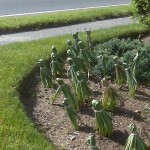
It may look artsy, but braiding your daffodil foliage prevents getting energy down to the bulb for next year’s display.
Spring Bulbs. You should not cut down or “braid” foliage of spring bulbs. It needs to mature to send energy into the bulb for next year’s bloom. But do deadhead the flowers. Perennials planted next to bulbs will hide the yellowing foliage and keep the area blooming through the summer.
Ticks are out in force already. Always use repellents and do regular tick checks after working or playing outside to prevent the growing variety of dangerous diseases spread by them.
2010, 2011 and 2012
Patience is a virtue in the garden. First, it was hot and dry, now it’s cold and wet. If you planted seeds for peas, lettuce, Swiss chard, leeks, beets, cabbage crops or onions, they are fine, enjoying the rain. If you pushed the season and planted green beans or corn or (oh dear!) tomatoes, the cold soil will yield nothing for your efforts. Don’t be fooled by what is for sale in the stores. Corn, cucumbers, squash, melons, peppers, eggplants and tomatoes need
warm soil. You can hurry things along a little by covering the soil with black plastic to warm it before planting, but warm weather vegetables need warm days and nights. Planting ‘warm weather’ crops before the soil temperature is a reliable 60 degrees an exercise in frustration.
And the same goes for flowers. Pansies, snapdragons and osteospermum are happy outside now, but wait for the weather to become reliably warm before you put out most of our summer time annuals. Marigolds, geraniums, coleus, begonias, fuschias, impatiens and many, many more need the same warm days and nights favored by tomatoes. A single cool night can stunt plants and affect the growth in your garden beds or containers throughout the summer.
Mulch, Mulch, mulch—As soon as the three-inch-plus rain stopped last week, I ordered mulch, and immediately spread it on wet ground, helping to seal the moisture in and preventing evaporation. Many of us mulch because we like the way it looks, but remember that mulch will hold the water in the ground and help plants better tolerate a dry summer. Mulch further reduces your work by preventing weeds from popping up. Whether you are spreading mulch by yourself or having it done, remember the mantra: not less than two (inches), not more than three. And never, never, never place mulch up against the bark of trees or shrubs. It keeps the bark that should be dry, moist, allowing disease and insects entry into the heart of your plants, ultimately killing them.
Spring bulbs and lilacs that have passed should be deadheaded now. Removing the old flower forces the plants energy back into the bulb, instead of trying to set seeds. Leave the foliage for all bulbs to mature naturally. Do not cut bulb foliage back until its work is finished and it has yellowed and collapsed. Later in the season, follow the same routine should for late spring and summer bulbs like allium and lilies. Also, the best time to prune spring flowering trees and shrubs is when their blooms are spent. By doing it just after the flowers have died, you ensure that you will not be removing any of the buds for next year’s flowers.
Many trees are already in bloom and more will be following soon. Leaves will be bursting out soon (if they haven’t already in your yard) so your pruning work should be wrapping up for spring. Remember it’s never the wrong time to remove dead or diseased wood. In some cases you may have been waiting to see if damaged shrubs have survived. Prune out any branches that don’t show green when scratched lightly with your thumbnail. When the spring bloomers have finished their bloom, you can prune them for shape or to encourage the new wood necessary for many many early blooming shrubs to produce the flowers next year.
Vegetable gardens Cool weather crops like peas, lettuce , onions, cabbage carrots, beets and swiss chard should be growing rapidly now. If the weather continues to warm, you may be able to plant beans Mother’s Day. But remember you are concerned with the soil, not the air, temperature. Do not plant hot weather crops such as tomatoes, squash, melons and peppers until the end of the month,. Wait until later in the month to buy seedlings (See article on th Society Row Plant Sale and Tomatomania). Even then, keep an eye on the nightly lows. Cool weather can stunt the growth of tender plants, slowing their growth and resulting the size of your crop.
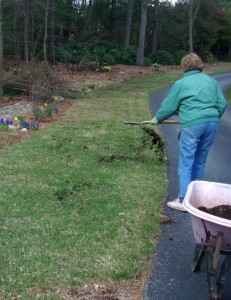 Lawns in New England do not need a spring feeding. The grass which was under stress all winter should be allowed to green up naturally after a stiff raking has cleaned the yard. A second feeding during the spring encourages a great deal of top growth, but at the price of a weaker root system. To keep your lawn greener during the heat of summer, encourage deeper roots. Add a thin ¼ inch layer of compost over the entire lawn. If you water, water only once a weekly and deeply—more than 2 inches, to encourage your roots to grow deeper, into cooler soil. If you don’t water in July or August, you will kill off lawn grubs who live in the top two inches and need moisture to survive. Grass goes dormant, but the grubs die. Finally check the numbers on any lawn fertilizer you purchase. If the first number given is very high and the second and third numbers low, you are encouraging rapid top growth without providing the elements needed for root growth.
Lawns in New England do not need a spring feeding. The grass which was under stress all winter should be allowed to green up naturally after a stiff raking has cleaned the yard. A second feeding during the spring encourages a great deal of top growth, but at the price of a weaker root system. To keep your lawn greener during the heat of summer, encourage deeper roots. Add a thin ¼ inch layer of compost over the entire lawn. If you water, water only once a weekly and deeply—more than 2 inches, to encourage your roots to grow deeper, into cooler soil. If you don’t water in July or August, you will kill off lawn grubs who live in the top two inches and need moisture to survive. Grass goes dormant, but the grubs die. Finally check the numbers on any lawn fertilizer you purchase. If the first number given is very high and the second and third numbers low, you are encouraging rapid top growth without providing the elements needed for root growth.
Red Lily Leaf Beetles—as soon as your plants are a foot high, you should start searching for Lily leaf beetles. You can drop them into containers of soapy water or simply squish them. Either technique means a small initial infestation does not become a large problem. Most healthy plants can survive small amounts of damage with no ill effects. Sprays seldom work because the beetles cover themselves with excrement as they feed. Trials have been conducted with a tiny parasitic wasp in a few areas. Someday these predators may make red lily leaf beetles a minor problem instead of a devastating one.
Container plantings I love containers—you can grow annual, perennials, shrubs and small trees, tropicals, vegetables or have a simple water garden. The stores are filling up with annuals right now but don’t be fooled into thinking that that can be put outdoors yet. Only the cold hardy plants such as pansies, violas and osteospermum can tolerate the dips to freezing we are certain to see in May. As beautiful as the marigolds, geraniums, petunias and others are, they cannot tolerate temperatures that flirt with frost. And perennials all in bloom because they are fresh from southern greenhouses should not be placed outside yet either. If you absolutely cannot resist putting containers outside, plan to carry them into a garage or shed when cold weather threatens. If that is not possible, use old blankets or sheets to cover the pots. But first push stakes down along the sides of the container to keep the weight off tender shoots and flower buds. Do not use plastic sheeting which will transmit the cold temperature to any leaf or flower it touches.
After spring bulbs pass their bloom, allow foliage to yellow and ‘ripen’ before being removed. It’s important because the foliage is responsible for passing nutrients down into the bulb to allow it to produce a new flower next year. Hide the foliage is by growing perennials and annuals around it. When the foliage turns is dead – likely by July – you can safely cut it at ground level, secure in the knowledge that there will be a new display of you favorite spring bulbs in 2010.
Fall blooming perennials like asters and chrysanthemums are best divided in May. They are starting to show their foliage now, so identifying, digging and dividing them is easier and you are giving them plenty of time to settle in and bloom before.
May is the month to fertilize your perennials. They’re entering their growth cycle for their late spring and summer displays, and the fertilizer ‘boost’ will ensure a long and colorful display as you add the nutrients to bolster both root and flower production. But remember: when applying fertilizer, less is best.
As the soil warms, mulch your beds. April was the time to take care of trees and shrubs; May is ideal for perennials and tender plants. Remember to never allow the mulch to touch the stem of the plant. Two inches of new mulch is about right – all you’re trying to do is replace the mulch from last year that has decomposed into the soil layer below. Ideally, you’ll have a total of two to four inches of mulch when you’re finished. Less, and weeds may grow through it. More, and you’re limiting the access of necessary water and oxygen to the soil below.
If you grow peonies, now is the time to place peony rings before the plants become too big and hard to work with. It’s a lot easier to guide the stems of this top heavy perennial into a ring than to stake individual stalks. Peony rings are useful throughout the summer corralling other exuberant perennials.
Do you want shorter plants with lots of flowers instead of leggy giants? You need to pinch back plants like asters and chrysanthemums four times during the spring and summer. Here’s an easy mnemonic: pinch them back Mother’s Day, Memorial Day, Father’s Day and the Fourth of July. With Mother’s Day this Sunday, it’s time to make your first pinch.
While there has already been a ninety-degree day in the Boston area this year and several days with temperatures above eighty, keep in mind that our average last frost date is May 20. We’re all tempted to put out those tender annuals early in the month, but a few cold nights can stunt those plants for the season, and a night with temperatures in the low thirties can kill them. So, if you have already put out annuals, watch the thermometer and cover any tender plants (both flowers and vegetables) until the danger or frost is past.
Finally, it’s not too late to start a vegetable garden. Cold weather crops – lettuce, peas and onions, for example – can already be planted. But many crops; like tomatoes, beans and squash; want soil temperatures of sixty degrees or better and you won’t see those in Eastern Massachusetts until much later in the month. So, lay out your garden now, but delay purchasing pots of tomato, pepper, melon and other hot weather crops until it is closer to the time to set them out. Your garden will be more bountiful for starting at the right time.
Everything seemed to arrive early this season, magnolias bloomed with forsythia, tulips while the crocus were still here. This means now is the time to prune back spring blooming shrubs and trees. Removing the oldest wood and crossing branches will make a stronger and healthier plant for the next year. As soon as the lilacs finish their bloom, add them to your to-do list. But don’t cut down the foliage of bulbs. It needs to naturally ripen (turn yellow) in order to put energy back in the bulb for next year’s flowers.
Wood ash from fireplaces (but not charcoal fires!) makes a wonderful soil additive. Use it more sparingly than lime to sweeten acidic soil around lilacs. Work in it into the soil in the vegetable garden before planting root crops such as beets, carrots, or radishes.
Get an early start protecting your hostas, strawberries and many flowering perennials from slugs and snails. Products containing iron phosphate are deadly to slugs, but not to pets or the environments. After eating these products, snails will stop feeding but not die immediately. Do not kill or remove the sick slugs. On occasion they are eaten by fellow slugs and the iron will kill the cannibal as well.
If you’ve never composted, now is a great time to start. Kitchen garbage that would otherwise go down the disposal and garden trimmings that would be bagged for the dump can be turned into compost, the black gold of gardening. You can use a fancy composter or a pile at the back of your property, but either way, you are recycling plant material back into your soil, reducing trash and improving your garden. For more information on composting and state subsidized composters, check the recycling website www.mass.gov/dep/recycle/reduce/composti.htm.
Weed, weed, weed because weeds pulled now will not produce seeds to bedevil you throughout the summer. Two to four inches of mulch, carefully kept from touching plants stems and tree trunks, will keep most new weeds from germinating while allowing water and air to percolate through. Think twice before using colored mulches. The coloring is often used to disguise old wood from unidentified sources. You are safest with a bark chip mulch produced locally.
In your vegetable garden, floating row covers can keep pests out. The spun material allows sunlight and water through while excluding bugs that might otherwise diminish your crop. On cool nights, the cover provides another 2 to 3 degrees of retained heat, perhaps enough to keep your crop from being stunted by the cold air.
When working outside, use sunscreen to protect your skin and mosquito repellents to avoid feeding that pest. Check for ticks after working outdoors to avoid Lyme disease. Removing standing water from empty containers, old tires or any place else standing water can accumulate to eliminate breeding sites. In water features, fish will eat mosquito larvae. If you don’t have fish, use mosquito dunks. Regularly clean out bird baths and replace the water.
Lawns should be mowed at three inches to shade out new weeds and keep grass roots cooler throughout the summer. It is too late now to apply crabgrass preventer, it has already germinated. If you find you have broad leaf weeds, spot treat rather than broadcasting weed killers over the entire lawn. Frequent applications of herbicides (such as weed killer and crab grass preventer) and pesticides will make the soil in your lawn and garden less fertile by killing off the microbes necessary for healthy plant growth.
